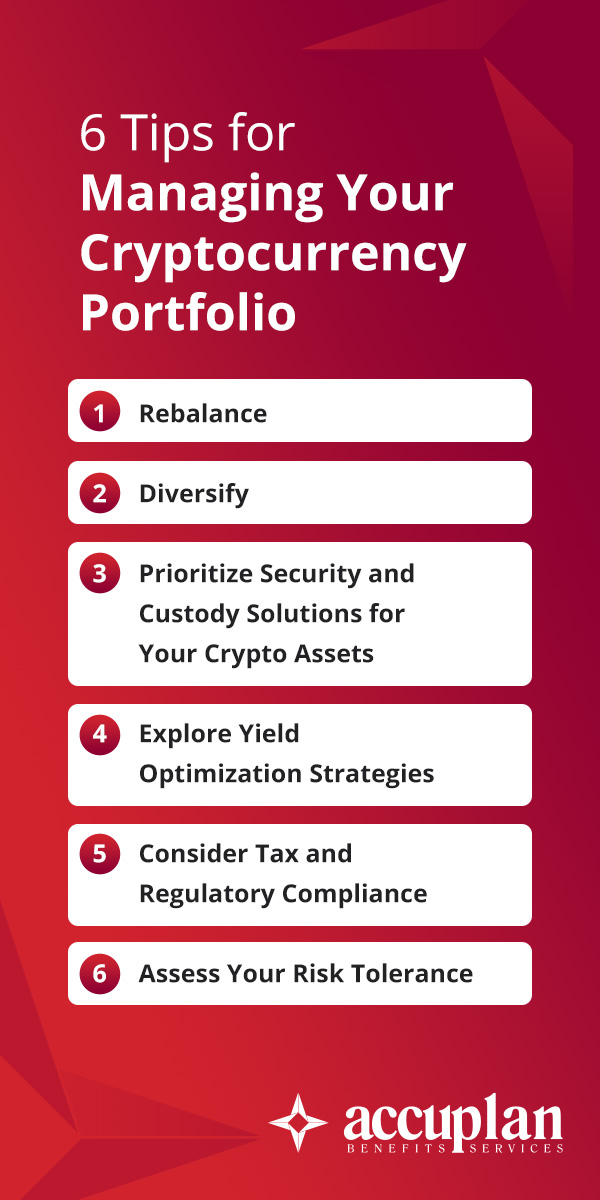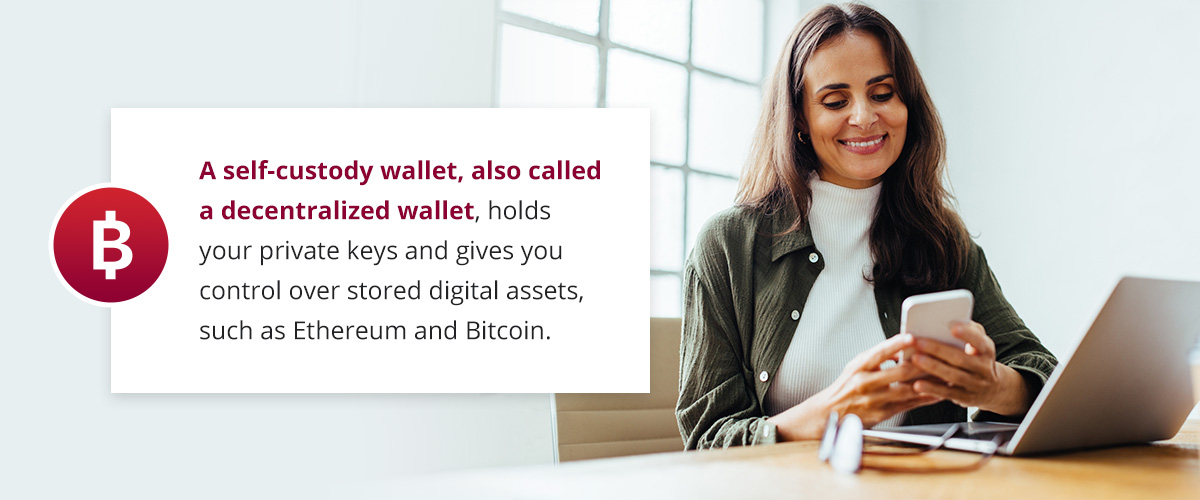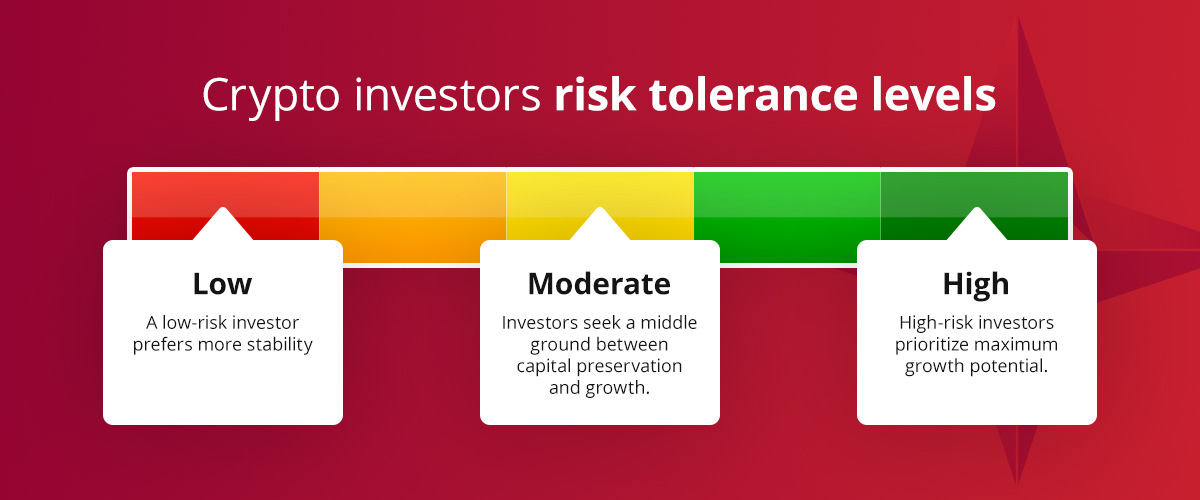
The cryptocurrency market is quickly gaining traction, with more assets emerging annually. Business owners and individual investors are exploring ways to use crypto and blockchain to grow their funds.
With these rapid developments comes the need for strategic tools to effectively manage crypto as part of a portfolio. Doing so involves unique challenges that set it apart from traditional asset management, such as extreme market volatility, high security risks and an evolving regulatory landscape.
This guide covers some of the best crypto portfolio tips to help you minimize volatility risk, maximize your investments and protect your peace of mind.
Understanding Crypto Asset Management
Managing your crypto portfolio is essential to a successful investment strategy. Crypto asset management is the process of buying and selling cryptocurrency for investments. It involves creating and actively monitoring a portfolio to track and increase your digital assets’ value, allocating based on your risk comfort and goals. Many people use crypto management platforms and tools to simplify tracking.
How Much of Your Portfolio Should Be Crypto?
When structuring your crypto portfolio, allocate around 1% to 5% to cryptocurrency. Typically, this percentage is sufficient to gain exposure without risking serious damage if things go south. Before integrating crypto into your portfolio, cover your other bases — such as building an emergency fund, putting away retirement savings and minimizing or eliminating high-interest debt.
6 Tips for Managing Your Cryptocurrency Portfolio

Once you feel ready to take your digital asset management to the next level, use these crypto portfolio tips when building your strategy.
1. Rebalance
This strategy aligns your crypto portfolio with your risk tolerance and reward goals. Regularly diversifying your investments can reduce the risk of market changes, as some assets stabilize while others become more volatile.
Fluctuating crypto prices will affect the target weights of individual tokens or categories within the portfolio. Rebalancing accounts for the fact that some assets may outperform others over time, which shifts your portfolio’s value. Regularly rebalancing lets you avoid circumstances where a single asset dominates value.
For instance, say that tokens within the gaming category increase in price — this would increase the category’s weighting in the portfolio. Selling these gaming tokens to rebalance will lower the category’s weighting to the target range.
You can rebalance at consistent intervals, such as monthly, quarterly or annually. Automated tools and portfolio trackers can also help you access real-time market updates, reducing the need for manual tracking and making it easier to adjust your allocations.
2. Diversify
Don’t put all your eggs in one basket when deciding how to manage your crypto portfolio. For example, if you only invest in a single token and it loses most or all of its value, this essentially wipes out your whole portfolio.
Diversification, or spreading your cryptocurrency investments across different sectors, minimizes market volatility. Rather than putting all your capital into a single asset, it increases your potential for stable, long-term returns and allows you to leverage growth opportunities across multiple market segments.
Try investing in a mix of cryptocurrencies to diversify your portfolio.
- Stablecoins: Pegging stablecoins to a stable asset, such as gold or a fiat currency like the U.S. dollar, maintains a steady value.
- Decentralized finance: DeFi systems rely on blockchain technology and smart contracts instead of traditional authorities like banks. They enable access to financial services like trading, borrowing, lending and earning interest without intermediaries.
- Meme coins: Meme coins like Dogecoin can be volatile but also have a high growth potential.
- Layer 2: Layer 2 scaling technologies improve transaction speed and cost-effectiveness by building on top of blockchains like Ethereum or Bitcoin.
- Gaming tokens: Blockchain-based games reward players with non-fungible tokens, which they can trade for stablecoins or fiat currency. Use these tokens to take advantage of the growing gaming sector.
- Governance tokens: Governance tokens give holders the right to vote on proposals, influencing decisions on decentralized projects like DeFi platforms.
- Utility tokens: Utility tokens grant access to a service, product or function within a specific blockchain ecosystem, rather than giving people ownership rights in a company. They act as digital tickets to get discounted fees on exchanges, access to exclusive features or rewards for viewing ads. While utility tokens are subject to less stringent regulations, their value can be volatile.
3. Prioritize Security and Custody Solutions for Your Crypto Assets

Since crypto is vulnerable to hacking, theft and permanent loss, secure storage is essential. While traditional banks have insurance protections and fraud-reversal procedures, cryptocurrency places security responsibilities on the owner. Your crypto wallet contains private keys that grant access to your funds.
A self-custody wallet, also called a decentralized wallet, holds your private keys and gives you control over stored digital assets, such as Ethereum and Bitcoin. It enables peer-to-peer cryptocurrency transactions and can connect directly with smart contracts, providing access to DeFi apps.
- Hot wallets: These software-based wallets live online — you can access the app on desktop, mobile or as a browser extension to send, receive and manage your crypto. Use a hot wallet for regular on-chain transactions, such as sending payments or interacting with decentralized apps.
- Cold wallets: Cold wallets store your private keys and crypto completely offline, isolating them from internet-based threats. They’re usually hardware, but they can also be paper-based. You’ll sign transactions on the storage device, then move them to the internet-connected device to broadcast to the blockchain network — all without exposing your private keys to the internet. While hot wallets are more convenient for frequent transactions, cold wallets tend to be more secure and better for long-term storage.
However, it’s a different story if you manage crypto in an individual retirement account. With this arrangement, a qualified custodian must legally hold digital assets on your behalf. That means you can’t personally manage the funds through hot or cold wallets — if you do, the IRS might assume you’ve taken possession of IRA assets, potentially triggering severe penalties.
Secure storage is vital for cryptocurrency in an IRA because it protects your retirement savings from catastrophic loss due to hacking, fraud or exchange failures. Robust storage is a must because cryptocurrencies lack the protections of traditional IRA assets, such as SIPC or FDIC insurance. Custody storage solutions safeguard the private keys that control digital assets, reducing the risk of theft and permanent loss associated with self-management.
4. Explore Yield Optimization Strategies
Yield optimization in cryptocurrency, primarily within DeFi, involves using automated tools and strategies to maximize returns on crypto assets. Auto-compounding and rebalancing analyze market conditions and adjust investments, positioning assets for the highest possible yields.
Here are examples of yield optimization strategies.
- Staking: Earn rewards in return for delegating or locking up your crypto assets in a Proof-of-Stake blockchain network.
- Yield farming: With yield farming, you supply your crypto to liquidity pools within DeFi platforms, allowing you to earn passive income in the form of interest, additional tokens or trading fees. Yield farming facilitates token exchanges, trading and lending within DeFi’s ecosystem, contributing to its operation and growth.
- Liquidity mining: Liquidity mining is a specific type of yield farming. It incentivizes users to provide assets to liquidity pools on decentralized exchanges. Your rewards are the project’s native token plus the fees generated by the liquidity pool.
5. Consider Tax and Regulatory Compliance
The IRS classifies cryptocurrency as property, not currency, so every transaction is taxable. That means you’ll need to report capital gains or losses from all exchanges and sales, plus crypto you received as income.
Capital gains and losses apply when you sell, exchange or use crypto that you hold as an investment. To calculate gain or loss for each transaction, you can subtract your cost basis — the original purchase price plus fees — from the fair market value at the time of the transaction.
Reporting requirements for crypto include the following:
- Answering the digital asset question on Form 1040
- Calculating capital gains and losses on Form 8949 and Schedule D
- Reporting ordinary income from crypto on Schedule 1 or Schedule C
- Keeping detailed records of all transactions
You’ll need to check “Yes” on Form 1040 if you engaged in any of these activities during the tax year:
- Sold, traded or exchanged crypto
- Received crypto as payment for property or services
- Received new crypto from mining, staking or similar activities
- Received new crypto from a blockchain splitting into two
- Disposed of financial interest in crypto
You can check “No” if your only crypto activity involved holding, transferring assets between your wallets or purchasing crypto with real currency.
You must stay informed and compliant with evolving crypto and IRS regulations. Additionally, keep diligent records to file accurate tax returns and prepare for an audit.
6. Assess Your Risk Tolerance

Determining your risk tolerance in a volatile market is crucial. It helps you understand the financial and emotional implications and create a practical strategy that aligns your investments with your comfort levels and objectives.
Crypto investors have varying risk tolerance levels.
- Low: A low-risk investor prefers more stability — such as through stablecoins or large-cap assets with more predictable returns — and values capital preservation over high growth. They may be newer to crypto or still learning, and might be uncomfortable with dramatic, rapid price fluctuations from high market volatility.
- Moderate: Moderate-risk investors seek a middle ground between capital preservation and growth. They’re willing to accept some volatility in exchange for potentially higher returns. They typically have a solid understanding of the crypto market and its underlying technology.
- High: High-risk investors prioritize maximum growth potential. They’re more comfortable with volatile assets and the possibility of substantial losses. They generally have a strong financial foundation and expert-level knowledge of the crypto market and technologies. High-risk traders see market fluctuations as buying opportunities instead of a cause for panic.
Before entering the crypto market, defining your investment goals, assessing your risk tolerance and determining your volatility comfort level will help you align your investment strategy with your risk appetite and goals.
Long-Term Planning — Retirement and Estate Integration
Integrating crypto into an IRA can be beneficial for investors, offering the potential for high returns and long-term growth, a more diverse retirement portfolio and reduced capital gains taxes. A self-directed IRA managed by a specialized custodian enables you to invest in cryptocurrency and other assets typically excluded from conventional IRAs.
Why Choose Accuplan for Your Self-Directed IRA?
At Accuplan, we make it easier than ever to invest in crypto through an IRA. Our secure, user-friendly platform allows you to buy, sell and trade digital assets within your retirement account, all without a separate crypto wallet.
As a trusted leader in self-directed Roth and traditional IRAs, we can guide you through the entire process, whether you’re expanding your existing portfolio or building one from the ground up. We’ve helped investors like you grow their retirement savings using cryptocurrency and other alternative assets.
With Accuplan, you can purchase crypto without going to an exchange beforehand. Getting started is easy with our three-step process.
- Set up your account: Fill out our application form and create your account in a few minutes.
- Fund your account: Transfer money into your retirement account.
- Buy, sell and trade: Start selling, buying or trading cryptocurrency within your IRA.
Diversify Your Crypto Portfolio Strategy With Accuplan
Our team understands the importance of professional guidance and support when managing crypto through a retirement account. That’s why we’ve developed a simplified process with clear, transparent fees, a secure investment platform and personalized support from our expert team.
If you’re ready to diversify your retirement portfolio, invest in crypto through an IRA and embrace the future of digital currency, Accuplan can help. Contact us today to learn more!
Disclaimer: Our information shouldn’t be relied upon for investment advice but simply for information and educational purposes only. It is not intended to provide, nor should it be relied upon for accounting, legal, tax or investment advice.
